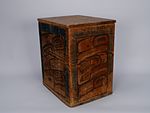Bentwood Box
About this object
History of use
Bentwood boxes were used primarily for storage of food, implements, and ceremonial regalia, but were also used for cooking and serving food. They were trade goods or gifts, and were symbols of wealth and prestige. Boxes used for ceremonial purposes were usually more highly decorated than those for utilitarian use.
Specific techniques
Bentwood, or kerfed-corner, containers are constructed by a process unique to the Northwest Coast Aboriginal peoples. The carver begins with a single straight-grained plank of red cedar, or sometimes yellow cedar, spruce, or yew. The surface of the plank is finished with chisels, adzes, and knives; in earlier times, it was smoothed further with sandstone or dried sharkskin. Then three parallel kerfs, or grooves, are carved out at measured points across the width of the board, at right angles to the long edge. The kerfs, which will become three corners of the box, allow the board to be steamed until the wood fibres are softened, and then carefully bent to form a box with symmetrical sides. The final corner, as well as a fitted base, are joined and fastened with pegs (through drilled holes) or laced with spruce root or twisted cedar withes (branches). Storage boxes also have fitted lids of cedar, hollowed from the inside. Finally, painted compositions may be applied to the completed box and shallow carving added to bring the forms into relief. A well-made bentwood box is watertight. Historically, most boxes were used to store preserved foods and material goods; plain cooking boxes could be used to steam or boil food by adding water and heated stones.
Physical description
Bentwood cedar box (a) with lid (b) has painted sides nailed to base and nails along seam corner. Each side has a design of staggered black eyes, some with red and white details, and a thick greenish blue border. The undecorated lid is made of two pieces of planked wood and has 4 strips of wood nailed to the underside.
Materials
Date Made
Before 1930
Date Acquired
8 Jan 2010
How Acquired
Donated
Credit Line
Measurements
Overall: 49.4 cm x 44.2 cm x 33.7 cm
Object Number
2779/1 a-b
